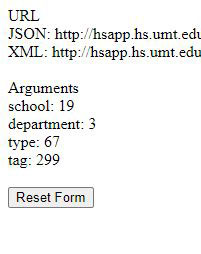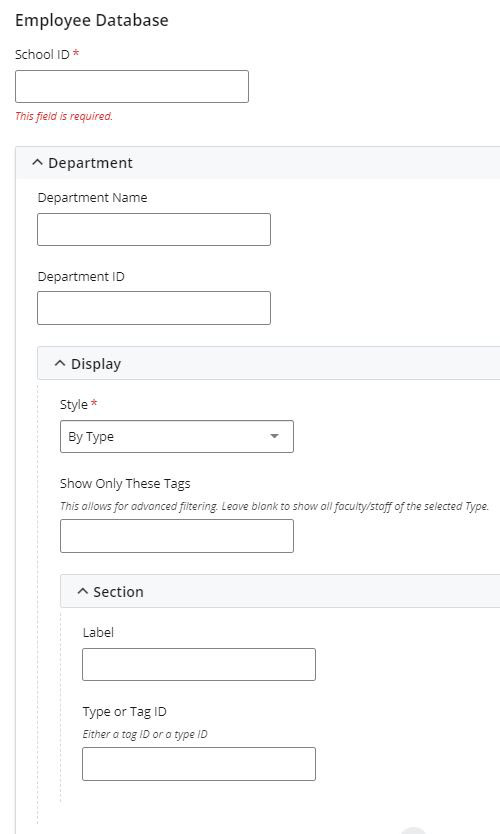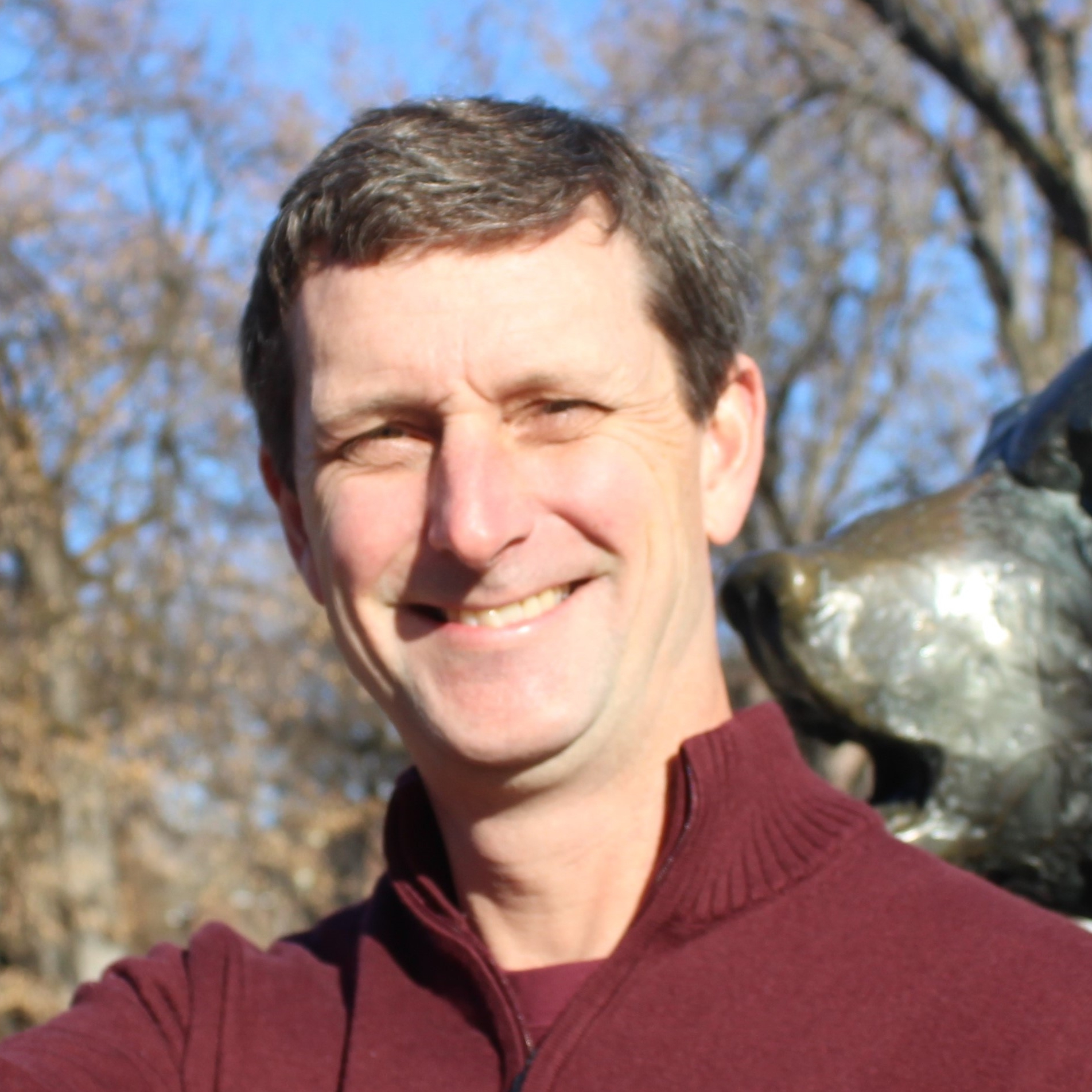Employee Database
How It Works
The employee database and its API Plugin are tools that can be used in conjunction with one another to display information about employees in campus departments. This page will walk you through using the Employee Database block on your page to display employee information.
Instructions
- Create the "Employee Database" block and add it to your site.
- Go to "Add Content" > "Blocks" > "Row Blocks" and select the "Employee Database" Block.
- Navigate to the Employee Database API Plugin and retrieve the numerical codes to enter into the Block.
- Select the "School" or "College" you are looking for.
- Select the "Department" you are looking for.
- Select the "Type" of employee you are looking for.
- Select the "Tag" associated with that employee Note: Some departments don't use tags, the query will revert to "Type" if this is the case.
- Take note of the numerical values of the School/College, Department, Type and Tag produced by the API.
- Back in Cascade, edit the "Employee Database" block you created. Enter the information generated from the API into the appropriate fields.
- Submit your changes.
- Publish your changes. NB: the Employee Database block does not display fully in Cascade, but only on the live site. Cascade will only display the numerical values retrieved from the API.
Breakdown of the API codes.
- School ID: Each school within the database is referenced by a unique ID.
- Department ID: In combination with the school ID, this identifies your department within the Faculty Database.
- ID(s): Each person in the system is associated with a personnel "type" (Professor, Adjunct, Staff, etc.), and you can filter by these IDs.
- Tag ID(s): Some departments choose to further categorize by research area or specialty with tags.


The section below is an example of what you should see after attaching the employee database block.
Douglas MacDonald
Professor, Director of Graduate Studies
Contact
- Office
- Corbin (Lab) 148
- Phone
- 406-243-5809
- douglas.macdonald@umontana.edu
- Office Hours
Fall 2021 office hours: Mondays and Wednesdays, Social Science Bldg 203, 10:00 to 11:50 or by appointment
email: douglas.macdonald@umontana.edu
- Website
- http://hs.umt.edu/YellowstoneArchaeology/default.php
- Curriculum Vitae
- View/Download CV
Personal Summary
Doug MacDonald studies Native American pre-contact history of the Great Plains and Rocky Mountains. His research project in Yellowstone National Park has been ongoing since 2007. More than 15 students have completed M.A. or Ph.D. degrees on Yellowstone archaeology in the last decade or so. MacDonald has published five books, including three on Yellowstone. The most recent, published in 2018 by the University of Washington Press, is entitled, Before Yellowstone: Native American Archaeology in the National Park. He also recently published an article with former student Matt Nelson on Paleoindian archaeology at Yellowstone Lake (Plains Anthropology 2018), as well as an article on Cougar Creek obsidian in American Antiquity. His research focus is lithic analysis, including study of the procurement, production, use, and discard of stone tools by Native American hunter-gatherers in the Greater Yellowstone Ecosystem.
Education
1987-1991 B.A., Anthropology, Honors, Brown University, Providence RI
1992-1994 M.A., Anthropology, Washington State University, Pullman
1995-1998 Ph.D., Anthropology. Washington State University, Pullman
Courses Taught
Fall Semester
Archaeology of Yellowstone (ANTY 150)
Archaeological Theory (ANTY 450)
Cultural Resource Management (ANTY 451)
Spring Semester
Archaeology of Montana (ANTY 352)
Cultural Resource Policy and Practice (ANTY 602)
Paleoindian Archaeology (ANTY 353)
Field of Study
North American Prehistoric Archaeology
Cultural Resource Management
Paleoindians
Yellowstone National Park
Selected Publications
2013 Understanding the Role of Yellowstone Lake in Prehistoric Hunter-Gatherer Subsistence and Settlement Systems. North American Archaeologist.
2012 Yellowstone Archaeology: Southern Yellowstone. (editor with E. Hale). University of Montana Contributions to Anthropology 13(2). In preparation.
2012 Montana Before History: 11,000 Years of Hunter-Gatherers in the Rockies and Plains. Mountain Press Publishing Company, Missoula. http://www.amazon.com/Montana-Before-History-Douglas-MacDonald/dp/0878425853/ref=sr_1_1?ie=UTF8&qid=1345753339&sr=8-1&keywords=montana+before+history
2012 Early and Middle Holocene Hunter-Gatherers in the Greater Yellowstone Ecosystem, U.S.A. (1st author with J. Gish). Chapter in Yellowstone Archaeology: Southern Yellowstone, University of Montana Contributions to Anthropology 13(2).
2012 Hunter-Gatherer Use of America’s Highest, Largest Lake: Comparative Analysis of Data from 26 Prehistoric Archaeological Features around Yellowstone Lake. Chapter in Yellowstone Archaeology: Southern Yellowstone, University of Montana Contributions to Anthropology 13(2).
2012, Differential Selection of Lithic Raw Materials by Prehistoric Hunter-Gatherers in the Upper Yellowstone River Valley, Montana/Wyoming. Submitted for inclusion in edited volume on High Elevation Archaeology in the West, edited by Terry Ozbun and Ron Adams, Simon Fraser University Press.
2012, Fishing Bridge Point (48YE381): A Stratified Prehistoric Site at Yellowstone Lake, Wyoming. In Review, Plains Anthropologist.
2012 Late Paleoindian versus Early Archaic Occupation of Yellowstone Lake, Wyoming (1st author with Gish and Hughes). Current Research in the Pleistocene: in press.
2011, Total Field Magnetics and Exploration for Paleoindian to Plains-Culture Targets; Yellowstone National Park, USA. Submitted for publication Proceedings of the 9th International Conference on Archaeological Prospection. DEU Center for Near Surface Geophysics and Archaeological Prospection, Izmur, Turkey (2nd author w/ Steve Sheriff)
2011 Yellowstone Archaeology, Northern Yellowstone, Editor (with E. Hale). University of Montana Contributions to Anthropology Volume 13(1).
2011 Late Archaic Lithic Technology and Land Use within the Gardiner Basin, Upper Yellowstone River, Montana/Wyoming. Yellowstone Archaeology: Northern Yellowstone. UM Contributions to Anthropology 13(1): 56-71.
2011 Prehistoric Lithic Raw Material Use in the Gardiner Basin, Montana (second author with J. Adams). Yellowstone Archaeology: Northern Yellowstone. UM Contributions to Anthropology 13(1): 98-106.
2011 Prehistoric/Historic Ecology and Land Restoration within the Gardiner Basin, Yellowstone National Park, Montana (1st author with Yu, Hale, Hektner, & Dick). Proceedings of the 2010 Yellowstone Science Conference: in press. Also in Yellowstone Archaeology: Northern Yellowstone. UM Contributions to Anthropology 13(1): 2-10.
2011 Steatite on the Juniata: Early Woodland Pottery at the Hopewell Site, Central Pennsylvania. Journal of Middle Atlantic Archaeology: 7-27.
2011 Fort Ancient Mortuary Practices at Clark Rockshelter Kentucky (with B. Manzano and B. Shreckengost). In review for publication, Proceedings of the 26th Annual Kentucky Heritage Council Archaeology Conference.
2010 Total Field Magnetic, Radar, and Archaeological Studies on the Shores of Yellowstone Lake, Yellowstone National Park, USA. ISAP News: 2-3.
2010 The Evolution of Folsom Fluting. Plains Anthropologist 54 (210): 39-54.
2010 The Yellowstone Bank Cache Site (24YE355): A Late Archaic Pelican Lake Occupation on the Upper Yellowstone River. Archaeology in Montana: 1-24.
2010 Decorrugation, Edge Detection, and Modeling of Total Field Magnetic Observations from a Historic Town Site, Yellowstone National Park, USA (2nd author with S. Sheriff). Archaeological Prospection 16.
2009 With Mica we Mourn: Ft. Ancient Mortuary Practices at Clark Rockshelter, Kentucky (first author with Manzano, Lothrop, Cremeens, Parker and Shreckengost). Midcontinental Journal of Archaeology 34: 249-277.
2009 The Montana-Yellowstone Archeological Project. Rethinking Protected Areas in a Changing World: Proceedings of the 2009 George Wright Conference: 270-276.
2009 Understanding Decision-Making among Prehistoric Hunter-Gatherers via the Study of Lithic Technological Organization. Lithic Technology 34(2): 71-92.
2008, The Evolution of Folsom Fluting. Submitted to American Antiquity (in review).www.cas.umt.edu/facultydatabase/FILES_Faculty/514/Folsom fluting paper all oct 30 07.pdf
2007, In press, The Role of Lithic Raw Material Availability and Quality in Determining Tool Kit Size, Tool Function, and Degree of Retouch: A Case Study from Skink Rockshelter (46NI445), West Virginia. In Lithic Technologies: Life-Cycles of Production and Retouch, edited by William Andrefsky, Jr., Cambridge University Press www.cas.umt.edu/facultydatabase/FILES_Faculty/514/MacDonald-Retouch-Final May 07.pdf
2007 Book Review of Folsom by David Meltzer. American Antiquity 72 (4)
2007, In press, A Clovis Occupation along Swift Run Gap, Virginia. Current Research in the Pleistocene Volume 24.
Holocene Land-Use, Settlement Patterns, and Lithic Raw Material Use in Central West Virginia. Archaeology of Eastern North America 34: 121-140.
2004 Early Paleoindians as Estate Settlers: Archaeological, Ethnographic, and Evolutionary Insights into the Peopling of the New World. The Settlement of the American Continents, edited by C. Michael Barton and Geoffrey Clark, University of Arizona Press.
2001 Grief and Burial in Prehistory: Reinterpreting Hohokam and Salado Burials via Kin Selection Theory. American Antiquity 66(4): 704-714. www.cas.umt.edu/facultydatabase/FILES_Faculty/514/MacDonald-grief-Hohokam.pdf
1999 Modeling Folsom Mobility, Mating Strategies, and Technological Organization in the Northern Plains. Plains Anthropologist 44(168): 141-161.
1998 Subsistence, Sex and Cultural Transmission in Folsom Culture. Journal of Anthropological Archaeology 17(3): 217-239. www.cas.umt.edu/facultydatabase/FILES_Faculty/514/macdonald folsom subsistence.pdf
1999 Reproductive Interests and Forager Mobility(first author with Barry S. Hewlett). Current Anthropology 40(4): 501-524.
Publications
2019 Cougar Creek: Quantitative Assessment of Obsidian Use in the Greater Yellowstone Ecosystem. American Antiquity: in press. (1st author w/ B.Horton and T. Surovell).
2018 Before Yellowstone: Native American Archaeology in the National Park (https://www.amazon.com/Before-Yellowstone-American-Archaeology-National/dp/0295742208/ref=pd_rhf_gw_p_img_2?_encoding=UTF8&psc=1&refRID=7AREKBM2K22FB4DD5VCB)
2018 Paleoindians of Yellowstone Lake: Interpreting Late Pleistocene-Early Holocene Hunter-Gatherer Land-Use in the Greater Yellowstone Ecosystem. Plains Anthropologist 63:1-28. (1st author with M.Nelson).
2018 Archeological Significance of Yellowstone Lake. Yellowstone Science 26(1): 53-62.
2017 11,000 Years of Native American Obsidian Use in Yellowstone. In Tracking the Human Footprint, pp. 69-71. Proceedings of the 14th Biennial Scientific Conference on the Greater Yellowstone Ecosystem, Big Sky, Montana.
2016 A GIS Predictive Model for Paleoindian Sites in Yellowstone. Archaeology in Montana: 45-68 (2nd author with M. Nelson)
2015, Differential Selection of Lithic Raw Materials by Prehistoric Hunter-Gatherers in the Upper Yellowstone River Valley, Montana/Wyoming. In Toolstone Geography of the Pacific Northwest, edited by Terry Ozbun and Ron Adams, Simon Fraser University Press: 208-217. (Second author with J. Adams)
2014 Archaeology of the Little Trail Creek Site (24PA1081), Gardiner, Montana. Archaeology in Montana 55(2): 1-34.
Affiliations
Society for American Archaeology
Register of Professional Archaeologists
Montana Archaeological Society
Plains Anthropological Society
Montana Historical Society
Specialized Skills
Lithic Analyst; Cultural Resource Management; Archaeology; Prehistoric Archaeology; Cultural Resource Management
Professional Experience
2006-present. Professor, Department of Anthropology. University of Montana.
1999-2006. Archaeology Manager/Principal Investigator. GAI Consultants, Inc. Pittsburgh
1997-1998 Faculty Lecturer. Department of Anthropology, Washington State University
1996-1997. Museum Assistant. Columbia River Basin NAGPRA Project, CNA/WSU
1995-1996. Advanced Lithic Analyst. Lake Ilo Project, North Dakota. WSU/CNA
1995. Co-Field Director. Hanford Reservation Survey. CNA/WSU
1993-1994, Crew Chief . Lake Ilo Archaeological Project, North Dakota. WSU
1991-1992. Archaeologist. University of Delaware Center for Archaeological Research.
1990. Archaeologist. Opuntia Meadows Site (46PA1028), Cody, Wy. CSU, Ft. Collins.

